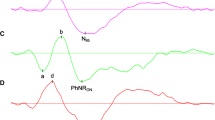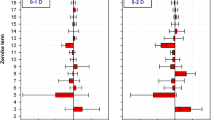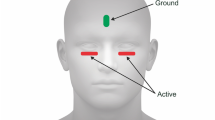Abstract
Transient pattern electroretinograms were recorded in 12 normal young volunteers with the use of 12′ and 30′ checkerboard stimuli and 1 c/deg and 2.5 c/deg vertical gratings. The intrasession repeatability of pattern electroretinograms was determined by employing alternative statistics to the frequently used correlation coefficients. Comparisons were made with the repeatability of cone electroretinograms elicited by ganzfeld stimulation. The coefficient of repeatability was substantially lower (better) for pattern electroretinogram b-wave implicit times than for a-wave implicit times and b-wave amplitudes, the latter having high coefficients of repeatability. Cone electroretinograms had better repeatability with respect to all three parameters. Digital filtering using a bandpass of 1–40 Hz was applied to the original pattern electroretinograms recorded with a bandpass of 1–250 Hz. Although peak definition was generally enhanced, repeatability did not show marked improvement. Differences between broadband analogue-filtered pattern electroretinograms and the same responses with highfrequency noise removed by digital filtering need to be taken into account. The coefficient of repeatability statistic appears to facilitate the assessment of pattern electroretinograms and permits the comparison of the repeatability of both implicit time and amplitude parameters irrespective of absolute values. The implications of the relatively poor repeatability of pattern electroretinogram b-wave amplitudes for clinical applications need to be considered.
Similar content being viewed by others
References
Holopigian K, Snow J, Seiple W, Siegel I. Variability of the pattern electroretinogram. Doc Ophthalmol 1988; 70: 103–15.
Bland JM, Altman DG. Measurement in medicine: the analysis of method comparison studies. Statistician 1983; 32: 307–17.
Bland JM, Altman DG. Statistical methods for assessing agreement between two methods of clinical measurement. Lancet 1986; i: 307–10.
Rimmer S, Katz B. The pattern electroretinogram: technical aspects and clinical significance. J Clin Neurophysiol 1989; 6: 85–99.
Celesia GG. Visual evoked responses. In: Owen JH, Davis H, eds. Evoked potential testing. Orlando, Fla.: Grune and Stratton, 1985: 1–54.
Ghigo J, Torres F. The use of digital filters in pattern-reversal visual evoked potentials. Am J EEG Technol 1988; 28: 15–22.
Bartel P, Blom M, Robinson E, Van der Meyden C, Sommers D, Becker P. Effects of chlorpromazine on pattern and flash ERGs and VEPs compared to oxazepam and to placebo in normal subjects. Electroencephalogr Clin Neurophysiol 1990; 77: 330–39.
British Standards Institution. Precision of test methods, I: Guide for the determination and reproducibility for a standard test method (BS5497, part 1). London: British Standards Institution, 1979.
Holder GE. Pattern electroretinography in patients with delayed pattern visual evoked potentials due to distal anterior visual pathway dysfunction. J Neurol Neurosurg Psychiatry 1989; 52: 1364–68.
Author information
Authors and Affiliations
Rights and permissions
About this article
Cite this article
Bartel, P., Becker, P. & Robinson, E. The intrasession repeatability of pattern electroretinograms and the effects of digital filtering. Doc Ophthalmol 76, 351–358 (1991). https://doi.org/10.1007/BF00142673
Accepted:
Issue Date:
DOI: https://doi.org/10.1007/BF00142673




